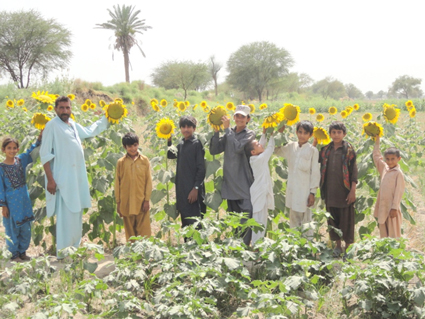Seeds of Change

Together, the 140 FAO-supported farmers have earned more than 3 million Rupees (US$30,000) from sunflowers and made another 800,000 Rupees (US$8,000) in the form of savings for the purchase of cooking oil
“We’ve seen that it is possible to achieve our dreams – to recover from floods and start a path to prosperity,” said farmers at Pir Jan Bajkani Village of Kashmore District, Sindh Province who received support from FAO to recover from the 2012 floods.
The village of Pir Jan Bajakani was among the most heavily affected areas of Sindh during the flood in September 2012. The disaster claimed the lives of 11 people and injured 885 in the community of six villages which includes Pir Jan Bajakani, Mohammad Khan Bajkani, Taimur Bajkani, Abdul Latif Bajkani, and Imam Bukka Cholaini. More than 1,000 acres of standing crops perished in the dirty water. More than 300 sheep and goats, and 125 buffalos died. Most of the houses were washed away, forcing people to move to other areas. Those who remained, felt hopeless. “For the first time in our memory, our lands were barren during the winter. Standing water killed our wheat crop, and we had no money left for the next season,” said the farmers.
To help Pir Jan Bajakani residents recover from the disaster and restore their livelihoods, FAO offered to provide seed and fertilizer for the 2012-2013 planting season. As a first step in the assistance process, FAO helped the villagers form a community organization which was to serve as a main recipient of support activities. A group of six men and women joined the new organization.
After evaluating the climate and soil in the area, FAO recommended that the villagers grow sunflower as their main cash crop. Sunflowers have a much shorter growth period and are more resistant to floods than wheat traditionally grown in the area.
In addition to its flood-resistance, FAO identified several other arguments in favour of sunflower: Most of the households in the area use adulterated forms of cooking oil which are extremely bad for human health. The sunflowers could provide the villagers with a much healthier alternative of cooking oil. Moreover, sunflower stalks could be used as fire wood, while leaves can be used for mulching to reduce water consumption in the gardens.
The villagers had never grown crops other than wheat in the winter and rice in the summer, and were very sceptical about sunflower. “Some of the people were making jokes, and others simply rejected the idea,” remembers Asif Ali Bajkani, president of Pir Jan Bajkani Community Organization.
Still, 140 farmers decided to try the new crop and only 8 villagers refused to take the FAO offer, feeling that the risks were too high. “We were not sure about the success of the sunflower, but FAO generated enough curiosity about it,” says Bajkani.
FAO provided each participating farmer with 2 kilograms of hybrid sunflower seed and a supply of Urea and DAP fertilizers for growing sunflowers on one acre of land. Additionally, each beneficiary received 0.5 kilograms of vegetable seeds to enable their families to grow vegetables for food until the sunflowers are harvested and sold.
FAO also trained the villagers how to plant and maintain the new crops. Some of the villagers opted to use a separate patch of land for a kitchen garden, while others grew vegetables between the rows of sunflower to maximize the use of the land and water.
During the next several months, the villagers were busy cultivating their land and growing vegetables. Each family grew enough vegetables to provide them food for 3-4 months, at an estimated value of at least 10,000 Rupees (US$100).
By the time the fields around the village got covered in large blooms of sunflower, the villagers were becoming more and more hopeful for success. “Ït was nice to see the fields of sunflowers turning their heads with the passage of the sun through the sky,” said one of the community members with a wide smile on his face.
FAO also helped the villagers to estimate sunflower yields and plan their use. The farmers calculated that their average yield would reach 400–500 kilograms of sunflower per acre. Together, the community decided to sell 60% (240-300 kilograms) of the crop at the going rate of 62.5 Rupees (US$0.6) per kilogram and set aside the remaining 40% (160-200 kilograms) to press oil for domestic consumption. The villagers estimated that this amount of sunflower seeds would produce 30 kilograms of high quality cooking oil for them – enough for 3-4 months of food preparation.
Barely four months later, in June, the sunflowers were ready to be harvested. The yields were as high as anticipated, and each of the households received nearly 40,000 Rupees in economic value (not including the use of the sunflower stalks for fuel). This amount included 21,875 Rupees earned from the sunflower seed, 7,500 Rupees in savings from the production of the sunflower oil, and 10,000 Rupees from vegetables. Each of the households had spent approximately 8,000 Rupees on inputs, which left 31,850 Rupees (US$320) of pure benefit for each family.
“I used my sunflower earnings to purchase wheat flour, rice seed, and fertilizer. Besides, for the first time ever, I have enough money to rent a tractor to prepare my land for the next planting season,” said farmer Sherbaz, one of the 140 villagers who grew sunflowers with FAO support. “Additionally, sunflowers have softened the land, and it’s is now much easier to cultivate. I am hoping that this will result in a good rice harvest as well,” added the farmer.
“We will definitely grow sunflowers again next year,” said Mr. Bajkani speaking on behalf of the community. “Now that we know how to take care of them properly, our next harvests will be even better.”
